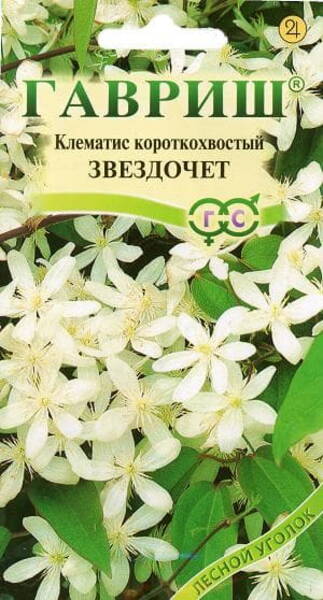Your shopping cart is empty!
Clematis brevicaudata
Clematis amurense (Clematis brevifolia) - Clematis brevicaudata.
It grows wild in the southern Far East and northern China, along river and stream valleys, in bird cherry and willow thickets, and among shrubs. Its woody vine climbs trees to heights of 5-7 m, with a vine up to 1.5 cm thick, and has numerous stems with longitudinally peeling bark. It is decorative with its beautiful leaves.
A beautifully flowering woody vine with numerous stems forming dense tangles, reaching heights of up to 5-7 m. The leaves are pinnate, with 3 or 5-7 leaflets, usually trilobate, with entire or serrated margins. The flowers are numerous, white, 1-2 cm in diameter, borne on long peduncles in elongated racemes. It blooms in July.
Clematis prefers sunny, sheltered locations and fertile, loose, sandy loam or loamy soil. It propagates by seeds and green cuttings.
Care consists of regular and abundant watering, weeding, and fertilizing. It is frost-hardy. Mature plants tolerate temperatures down to -23-25°C. Young plants are covered with spruce branches, as in particularly harsh winters they can freeze to the snow level, but they quickly regrow in the spring.
When propagated by seed, sowing occurs in November, and seedlings emerge in March-April. When sowing seeds in spring, in March-April, seedlings emerge in 40-60 days. Stratification for 2.5-3 months at 5°C promotes uniform germination. At the cotyledon stage or with 1-2 pairs of true leaves, seedlings are pricked out into ridges and shaded for about a month. When the seedlings have 2-3 pairs of new leaves, the shade is removed.
The soil around clematis is loosened and mulched with a layer of 2-3 cm to protect the root system from overheating. It can overwinter in Estonian conditions without removing the vine from its support or pruning the aboveground portion.
It grows wild in the southern Far East and northern China, along river and stream valleys, in bird cherry and willow thickets, and among shrubs. Its woody vine climbs trees to heights of 5-7 m, with a vine up to 1.5 cm thick, and has numerous stems with longitudinally peeling bark. It is decorative with its beautiful leaves.
A beautifully flowering woody vine with numerous stems forming dense tangles, reaching heights of up to 5-7 m. The leaves are pinnate, with 3 or 5-7 leaflets, usually trilobate, with entire or serrated margins. The flowers are numerous, white, 1-2 cm in diameter, borne on long peduncles in elongated racemes. It blooms in July.
Clematis prefers sunny, sheltered locations and fertile, loose, sandy loam or loamy soil. It propagates by seeds and green cuttings.
Care consists of regular and abundant watering, weeding, and fertilizing. It is frost-hardy. Mature plants tolerate temperatures down to -23-25°C. Young plants are covered with spruce branches, as in particularly harsh winters they can freeze to the snow level, but they quickly regrow in the spring.
When propagated by seed, sowing occurs in November, and seedlings emerge in March-April. When sowing seeds in spring, in March-April, seedlings emerge in 40-60 days. Stratification for 2.5-3 months at 5°C promotes uniform germination. At the cotyledon stage or with 1-2 pairs of true leaves, seedlings are pricked out into ridges and shaded for about a month. When the seedlings have 2-3 pairs of new leaves, the shade is removed.
The soil around clematis is loosened and mulched with a layer of 2-3 cm to protect the root system from overheating. It can overwinter in Estonian conditions without removing the vine from its support or pruning the aboveground portion.













